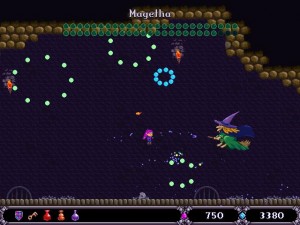Jasper’s Journeys: Finishing Up
When I was trying to google for information on how many levels Jarsper’s Journeys contains, one of the false leads I kept turning up was a review that talked about having difficulty with the final boss. The person who wrote it wanted to buy a triple-shot potion from the inn to make it easier, but found to his dismay that he was just a few coins short of being able to afford it. If I wasn’t already hoarding my coins, this sad story would have convinced me to start. However, my experience turned out completely different: by the end, I had thousands of coins and nothing to spend them on. It was as pure an example of the hoarding problem as you could hope to witness. In the earliest levels, I was reluctant to buy potions because they were expensive and I didn’t know if I’d need the cash later. I did start buying stuff toward the end, but the fact is, the game never really gets all that hard. Particularly if you’re exploring: many of the tougher fights can be skipped if you find the right secret passages.
I can’t say I got every treasure in the game, because there are places where this is just plain impossible. Sometimes you have a choice of path from A to B, and you can’t go back to get the treasures on both paths. This doesn’t happen often, but it does happen. Also, there’s a significant amount of cash emitted by slain monsters, little golden coins and stars that bounce away in random directions and then vanish, like rings in Sonic the Hedgehog. It’s rare that I manage to get all the coins from even a middling enemy. When you kill a boss, it explodes into a cascade of coins, and there’s no way you can get them all before they disappear. All you can do is try to be in the thickest part of the storm.
Not every level has a boss, by the way. Maybe half do, and a couple of them are among those tough-but-skippable fights I mentioned. The first couple of bosses, the anthropomorphic Armored Pig and the Fire-Breathing Ogre, show up as non-bosses in later levels, which is a little strange, because usually when that happens in games, it’s a sign of your escalating power, and there’s no escalation of power here. There’s just escalation of difficulty.
You do get increased firepower from a couple of potions, but it only lasts to the end of the level. Of course, you get the opportunity for maximal firepower when facing the end boss, which means not just the aforementioned triple-shot, but the butterfly as well. The butterfly is like the drones or multiples in various spaceship-themed shooters: it floats above your head (sometimes lagging behind you a little) and shoots along with you. Not only does this increase the area covered by your shots, there are places where it lets you shoot from positions of complete safety, hitting a monster on the floor above you.
 The end boss is of course the witch who stole your cat, who flies around on a broomstick, forcing you to keep jumping to shoot at her. She’s very much in the classical vein for a shooter boss, with multiple attack routines that saturate the screen with projectiles of various sorts: expanding rings of magic missiles, curving clusters of fireballs, bubbles that release frogs or bats. All of these missiles can be destroyed with your own shots, and you pretty much have to take advantage of this just to carve out a safe place to stand. More firepower will be expended on neutralizing danger than will actually hit the witch, particularly since the witch tends to vanish briefly whenever a shot connects. Anyway, it was nice getting a fight with some variety in it, because all of the prior bosses were relatively simple in their behavior, with only one attack routine each.
The end boss is of course the witch who stole your cat, who flies around on a broomstick, forcing you to keep jumping to shoot at her. She’s very much in the classical vein for a shooter boss, with multiple attack routines that saturate the screen with projectiles of various sorts: expanding rings of magic missiles, curving clusters of fireballs, bubbles that release frogs or bats. All of these missiles can be destroyed with your own shots, and you pretty much have to take advantage of this just to carve out a safe place to stand. More firepower will be expended on neutralizing danger than will actually hit the witch, particularly since the witch tends to vanish briefly whenever a shot connects. Anyway, it was nice getting a fight with some variety in it, because all of the prior bosses were relatively simple in their behavior, with only one attack routine each.
Overall, the game is faux SNES-era in both its graphics and its moment-to-moment gameplay, but it gives me an impression that it’s probably better than most of the games it imitates — that it’s designed to capture the way we like to remember platformers of that vintage, rather than the way they actually were.
 Comments(0)
Comments(0)